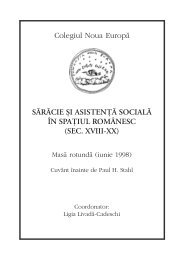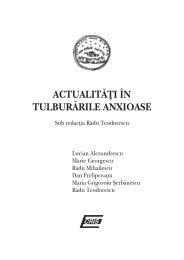New Europe College Regional Program Yearbook 2001-2002
New Europe College Regional Program Yearbook 2001-2002
New Europe College Regional Program Yearbook 2001-2002
Create successful ePaper yourself
Turn your PDF publications into a flip-book with our unique Google optimized e-Paper software.
N.E.C. <strong>Yearbook</strong> <strong>2001</strong>-<strong>2002</strong><br />
esp. pp. 3-40, 116-148, 169-197; also BERLINER GESCHICHTSWERKSTATT,<br />
ed., Alltagskultur, Subjektivitaet und Geschichte,Verlag Westfallisches<br />
Dampfoot, Münster, 1994.<br />
19 Stanley Cavell speaks about the “uncanniness of the ordinary” that both<br />
resists and invites philosophical discussion. – See CAVELL, Stanley, In Quest<br />
of the Ordinary: Lines of Skepticism and Romanticism, University of Chicago<br />
Press, Chicago, 1988.<br />
20 HAROOTUNIAN, Harry, History’s Disquiet: Modernity, Cultural Practice,<br />
and the Question of Everyday Life, Columbia University Press, <strong>New</strong> York,<br />
<strong>2001</strong>, 19.<br />
21 It is out of doubt that new urban developments are not only a stage where to<br />
look for and to observe the impact of the <strong>Europe</strong>an influences. They are, in<br />
some sense, part of the <strong>Europe</strong>anization, too. The division of the material<br />
aims mostly clearer presentation rather than imposing predestined statements.<br />
22 Quoted by ROSENTHAL, Steven, The Politics of Dependency: Urban Reform<br />
in Istanbul, Greenwood Press, Westport (Conn.)/London, 1908, 3.<br />
23 See GEORGEON, Francois, “A la veille de la guerre, des voyageurs”, in<br />
YERASIMOS, Stephanos, ed. Istanbul, 1914-1923 : Capitale d’un monde<br />
illusoire ou l’agonie des vieux empires, Editions Auttrement, Paris, 1992,<br />
34. On changes in the capital city of the Ottoman Empire see ROSENTHAL,<br />
Steven, op. cit., as well as ÇELIK, Zeynep, The Remaking of Istanbul: Protrait<br />
of an Ottoman City in the Nineteenth Century, University of Washington<br />
Press, Seattle and London, 1986.<br />
24 While saying ‘Ottoman model’ I think of the concept of ‘Islamic city’. It has<br />
passed a lot of avatars by now but usually it is its external aspects mainly that<br />
defined it: city which usually grew around important nodal points in the<br />
imperial system, expressly concerned with maintaining Ottoman power<br />
against the local population and with the protection of trade routes,<br />
characterised by its small curved streets, the impasses, the houses with inner<br />
yards, etc., where the city life did not happen on the streets but in private. –<br />
For further clarifications on this see YERASIMOS, Stephanos, “A propos des<br />
reformes urbaines des Tanzimat”, in DUMONT, Paul et Francois<br />
GEORGEON, eds. Villes Ottomanes a la fin de l’Empire, Editions L’Harmattan,<br />
Paris, 1992, 17-32.<br />
25 UBICINI, A., La Turquie actuelle, Hachette, Paris, 1855, 77-78.<br />
26 LEWIS, B., Emergence of Modern Turkey, Oxford University Press, 1961,<br />
102-103.<br />
27 For comparison: at about the same time, in 1821, Athens’ population was<br />
around 10,000 – and it still was 13 years before its becoming a capital of<br />
Greece; in 1846, about 19,000 people were living in Belgrade. – HEPPNER,<br />
Harald, ed. Hauptstädte in Südosteuropa: Geschichte, Funktion, Nationale<br />
Symbolkraft, Böhlau, Wien-Köln-Weimar, 1994, data from different articles.<br />
28 HEPPNER, H. ed. Hauptstädte in Südosteuropa, 49.<br />
164







